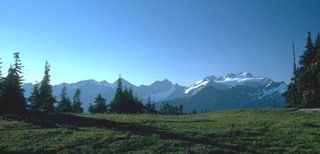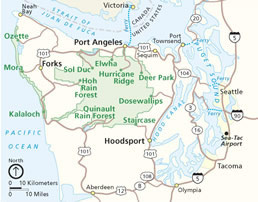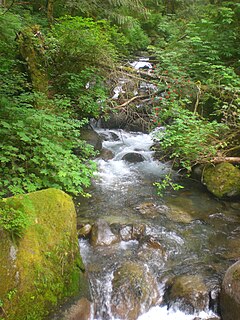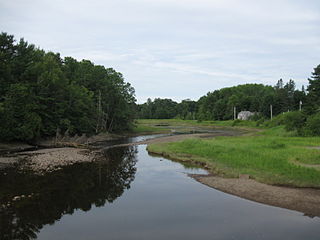| Snahapish River | |
| River | |
| Country | United States |
|---|---|
| State | Washington |
| Region | Olympic Peninsula |
| County | Jefferson |
| Source | Olympic Mountains |
| - elevation | 735 ft (224 m) [1] |
| - coordinates | 47°45′41″N124°8′0″W / 47.76139°N 124.13333°W [2] |
| Mouth | Clearwater River |
| - elevation | 270 ft (82 m) [3] |
| - coordinates | 47°39′18″N124°10′36″W / 47.65500°N 124.17667°W Coordinates: 47°39′18″N124°10′36″W / 47.65500°N 124.17667°W [2] |
| Length | 10.7 mi (17.2 km) [4] |
| Basin | 20 sq mi (52 km2) [5] |
The Snahapish River is a river in the U.S. state of Washington. It is a tributary of the Clearwater River, which in turn flows into the Queets River.

A river is a natural flowing watercourse, usually freshwater, flowing towards an ocean, sea, lake or another river. In some cases a river flows into the ground and becomes dry at the end of its course without reaching another body of water. Small rivers can be referred to using names such as stream, creek, brook, rivulet, and rill. There are no official definitions for the generic term river as applied to geographic features, although in some countries or communities a stream is defined by its size. Many names for small rivers are specific to geographic location; examples are "run" in some parts of the United States, "burn" in Scotland and northeast England, and "beck" in northern England. Sometimes a river is defined as being larger than a creek, but not always: the language is vague.

In the United States, a state is a constituent political entity, of which there are currently 50. Bound together in a political union, each state holds governmental jurisdiction over a separate and defined geographic territory and shares its sovereignty with the federal government. Due to this shared sovereignty, Americans are citizens both of the federal republic and of the state in which they reside. State citizenship and residency are flexible, and no government approval is required to move between states, except for persons restricted by certain types of court orders. Four states use the term commonwealth rather than state in their full official names.

Washington, officially the State of Washington, is a state in the Pacific Northwest region of the United States. Named for George Washington, the first president of the United States, the state was made out of the western part of the Washington Territory, which was ceded by Britain in 1846 in accordance with the Oregon Treaty in the settlement of the Oregon boundary dispute. It was admitted to the Union as the 42nd state in 1889. Olympia is the state capital; the state's largest city is Seattle. Washington is sometimes referred to as Washington State, to distinguish it from Washington, D.C., the capital of the United States, which is often shortened to Washington.
Contents
The Snahapish River is 10.7 miles (17.2 km) long. [4] Its drainage basin is 20 square miles (52 km2) in area. [5]

A drainage basin is any area of land where precipitation collects and drains off into a common outlet, such as into a river, bay, or other body of water. The drainage basin includes all the surface water from rain runoff, snowmelt, and nearby streams that run downslope towards the shared outlet, as well as the groundwater underneath the earth's surface. Drainage basins connect into other drainage basins at lower elevations in a hierarchical pattern, with smaller sub-drainage basins, which in turn drain into another common outlet.
















